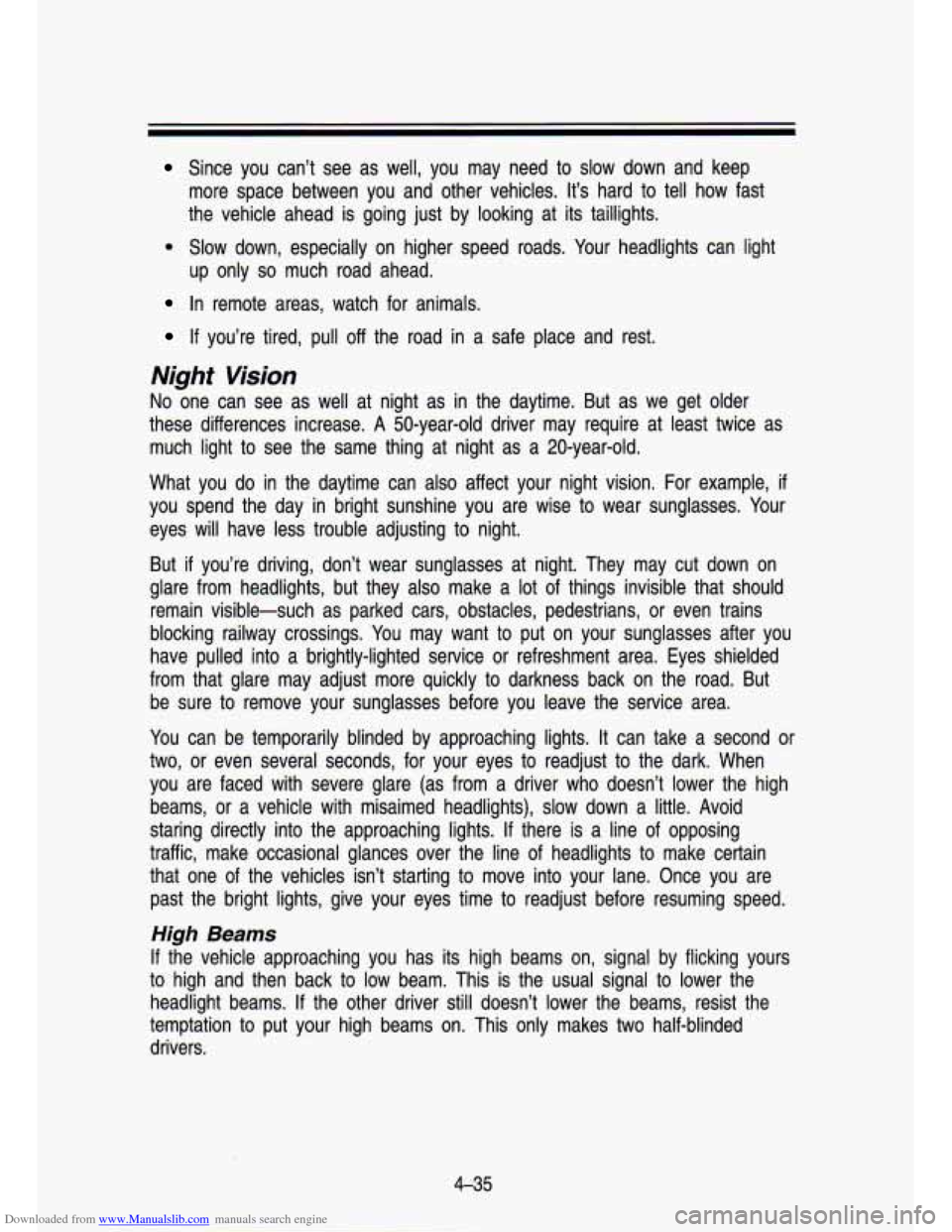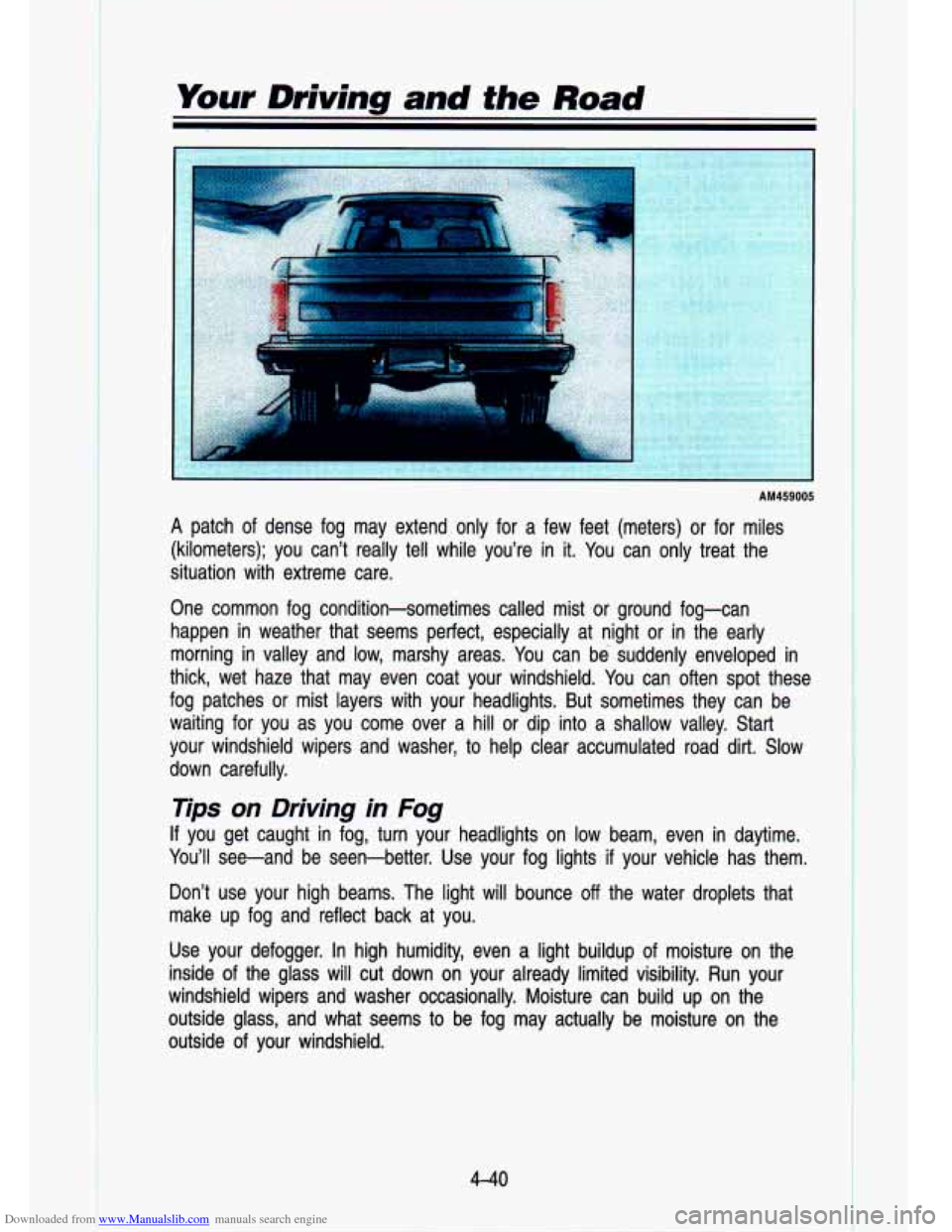Page 124 of 356
Downloaded from www.Manualslib.com manuals search engine Features & Controls
SHIFT Indicator Light
1
KO287
This light with the SHIFT symbol is on the instrument cluster of some vehicles
with manual transmissions. The
SHIFT indicator light will help you get the
best fuel economy. See “Shift Indicator Light” in this section.
Headlight High Beam Indicator Light
L
This light with the blue high beam symbol is on the instrumen\
t cluster. The
high beam indicator is on whenever you use your high beam headlights. For
more details about high beams, see “Headlight High-Low Beam \
Changer” in
this section.
2-72
Page 189 of 356

Downloaded from www.Manualslib.com manuals search engine Since you can’t see as well, you may need to slow down and keep
more space between you and other vehicles. It’s hard to tell how fast
the vehicle ahead is going just by looking at its taillights.
@ Slow down, especially on higher speed roads. Your headlights can light
up only
so much road ahead.
In remote areas, watch for animals.
If you’re tired, pull off the road in a safe place and rest.
Night Wsion
No one can see as well at night as in the daytime. But as we get older
these differences increase. A 50-year-old driver may require at \
least twice as
much light to see the same thing at night as a 20-year-old.
What you do in the daytime can also affect your night vision. For \
example,
if
you spend the day in bright sunshine you are wise to wear sunglasses. Your
eyes will have less trouble adjusting to night.
But
if you’re driving, don’t wear sunglasses at night. They may cut down on
glare from headlights, but they also make a lot of things inv\
isible that should remain visible-such as parked cars, obstacles, pedestrians, or even trains
blocking railway crossings. You may want
to put on your sunglasses after you
have pulled into a brightly-lighted service or refreshment area. Eyes shielded
from that glare may adjust more quickly to darkness back on the road. But
be sure
to remove your sunglasses before you leave the service area.
You can be temporarily blinded by approaching lights. It can take a second or
two, or even several seconds, for your eyes to readjust to the dark. When
you are faced with severe glare (as from a driver who doesn’t lower the high
beams, or a vehicle with misaimed headlights), slow down a li\
ttle. Avoid
staring directly into the approaching lights.
If there is a line of opposing
traffic, make occasional glances over the line of headlights to make certain
that one of the vehicles isn’t starting to move into your lane. Once you are
past the bright lights, give your eyes time to readjust before\
resuming speed.
High Beams
If the vehicle approaching you has its high beams on, signal by flicking yours
to high and then back to low beam. This is the usual signal to lower the
headlight beams.
If the other driver still doesn’t lower the beams, resist the
temptation to put your high beams on. This only makes
two half-blinded
drivers.
4-35
Page 190 of 356

Downloaded from www.Manualslib.com manuals search engine Your Driving and the Road
On a freeway, use your high beams only in remote areas where you won’t
impair approaching drivers. In some places, like cities, using high beams is
illegal.
When you follow another vehicle on a freeway or highway, use \
low beams.
True, most vehicles now have day-night mirrors that enable the \
driver to
reduce glare. But outside mirrors are not of this type and high beams from
behind can bother the driver ahead.
A Few More Night Driving Suggestions
Keep your windshield and all the glass on your vehicle clean-i\
nside and out.
Glare at night is made much worse by dirt on the glass. Even the inside of
the glass can build up a film caused by dust. Tobacco smoke \
also makes inside glass surfaces very filmy and can be a vision hazard
if it’s left there.
Dirty glass makes lights dazzle and flash more than clean glas\
s would,
making the pupils of your eyes contract repeatedly. You might even want to
keep a cloth and some glass cleaner in your vehicle
if you need to clean
your glass frequently.
Remember that your headlights light up far less of a roadway when you are
in a turn or curve.
Keep your eyes moving; that way, it’s easier to pick out dimly lighted objects.
Just as your headlights should be checked regularly for proper \
aim,
so should
your eyes be examined regularly. Some drivers suffer from night\
blindness-the inability to see in dim light-and aren’t even aware of
it.
4-36
Page 194 of 356

Downloaded from www.Manualslib.com manuals search engine I. Your Driving and the Road
I-
AM459005
A patch of dense fog may extend only for a few feet (meters) or fo\
r miles
(kilometers); you can't really tell while you're in it. You can only treat the
situation with extreme care.
One common fog condition-sometimes called mist or ground fog-can
happen in weather that seems perfect, especially at night or in the early
morning in valley and low, marshy areas. You can be suddenly enveloped in
thick, wet haze that may even coat your windshield. You can o\
ften spot these
fog patches or mist layers with your headlights. But sometimes \
they can be
waiting for you as you come over a hill or dip into a shallow valley. Start
your windshield wipers and washer, to help clear accumulated ro\
ad dirt. Slow down carefully.
Tips on Driving in Fog
If you get caught in fog, turn your headlights on low beam, even in daytime.
You'll see-and be seen-better. Use your fog lights
if your vehicle has them.
Don't use your high beams. The light will bounce
off the water droplets that
make up fog and reflect back at you.
Use your defogger. In high humidity, even a light buildup of moisture on the
inside of the glass will cut down on your already limited visibility. Ru\
n your
windshield wipers and washer occasionally. Moisture can build up\
on the
outside glass, and what seems to be fog may actually be moisture on the
outside of your windshield.
..
_. , .
I t
4-40
R
Page 312 of 356
Downloaded from www.Manualslib.com manuals search engine Service & Appearance Cam
Lamp And Bulb Data
Exterior Lamps
Check Gages Indicator' Daytime Running Lights Indicator'
Daytime Running Lights Indicator2
..-
Charging System Indicator' High Beam Indicator'
High Beam lndicato?
I
Quantity 1 1
Trade No.
PC1 94
PC1 74
PC1 94
-
Instrument Cluster Illumination' 6 3 PC1 68
Malfunction Indicator Lamp (Service Engine 1 .7 PC74
Soon)'
Malfunction Indicator Lamp (Service Engine
Soon)'
I I pc194
Seat Belt Indicator'" 1 2 PC1 94
Shift Indicator (PRNDL)'
1 2 PC1 94
Tachometer Warning Band'
1 2 PC1 94
Turn Signal Indicator'
2 .7 PC74
Upshift Indicator' 1 .7 PC74
Upshift Indicator2 1
2 PC1 94
'With Standard Instrument Cluster 'With Digital Instrument Cluster
6-64